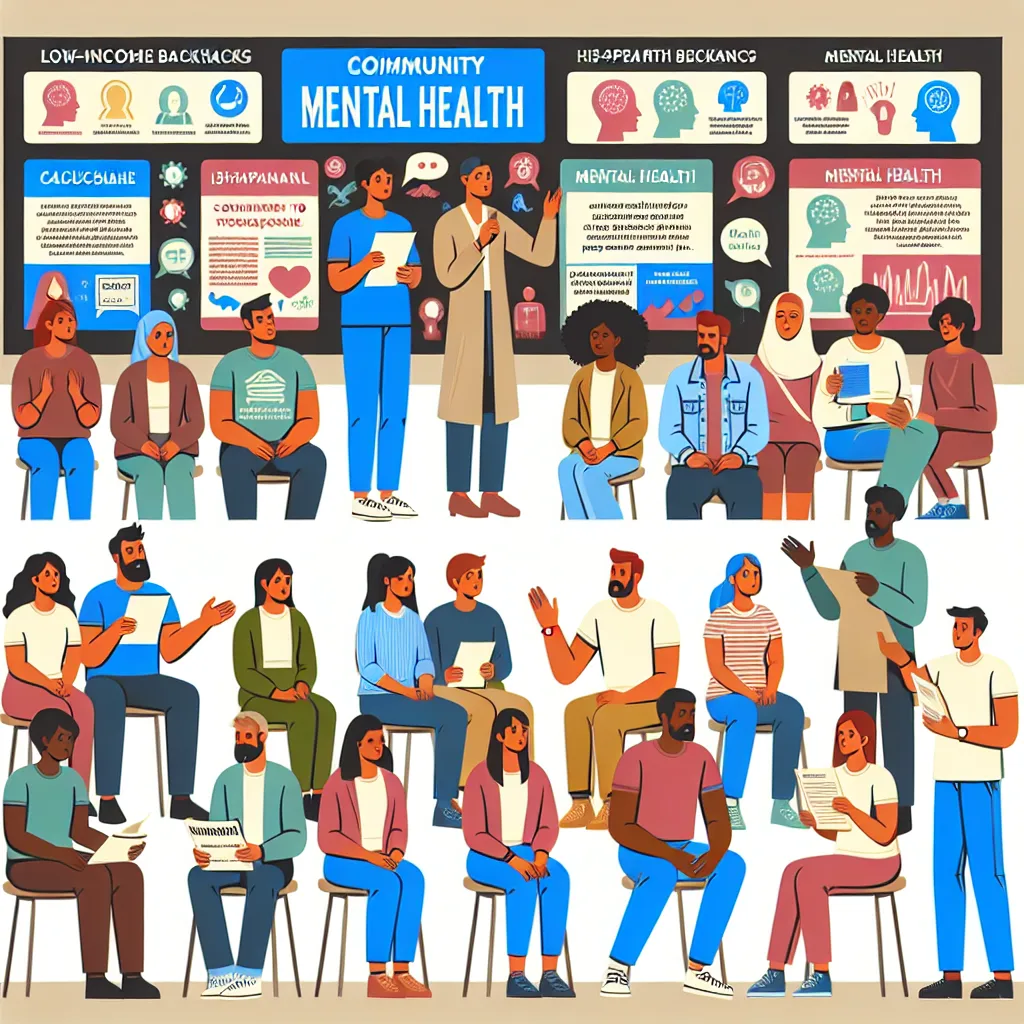Mental health in low-income families is a critical topic that has been gaining attention in recent IELTS exams. Based on past exam trends and current global issues, it’s highly likely that this theme will continue to appear in future tests. Let’s examine a relevant question that has appeared in recent IELTS Writing Task 2 exams:
Many low-income families face challenges in accessing mental health services. What are some ways to promote mental health awareness and support in these communities? Discuss the potential benefits and drawbacks of your suggestions.
Analysis of the Question
This question requires candidates to:
- Identify ways to promote mental health awareness and support in low-income communities
- Discuss the potential benefits of these suggestions
- Consider possible drawbacks of the proposed solutions
The task involves both idea generation and critical analysis, making it a complex question suitable for Testing higher-order thinking skills.
 Mental Health Awareness Campaign
Mental Health Awareness Campaign
Sample Essay 1 (Band 8-9)
Mental health issues can be particularly challenging for low-income families due to limited access to resources and support. This essay will explore several strategies to promote mental health awareness and support in these communities, along with their potential benefits and drawbacks.
One effective approach is to implement community-based mental health education programs. These initiatives could involve workshops, seminars, and informational campaigns tailored to the specific needs and cultural contexts of low-income communities. The primary benefit of this strategy is increased awareness and destigmatization of mental health issues, encouraging individuals to seek help when needed. However, a potential drawback is the challenge of ensuring consistent participation and engagement, especially given the time constraints many low-income families face.
Another viable solution is to integrate mental health services into existing community centers or schools. This approach would make mental health support more accessible and familiar to community members. The main advantage is the reduction of barriers to access, as people can receive support in familiar environments. Nevertheless, a possible drawback is the risk of overcrowding these facilities or stretching their resources too thin, potentially compromising the quality of both mental health services and their primary functions.
Developing a network of trained community mental health workers is also crucial. These individuals, ideally from the community itself, can provide basic mental health support and act as liaisons between families and professional services. This strategy benefits from leveraging local knowledge and building trust within the community. However, a challenge lies in ensuring these workers receive adequate training and support to handle complex mental health issues effectively.
Lastly, leveraging technology through telehealth services and mental health apps can significantly expand access to support. This approach offers flexibility and privacy, which can be particularly valuable in communities where stigma around mental health persists. The primary advantage is the potential for wide-reaching, cost-effective support. However, the main drawback is the digital divide, as not all low-income families may have reliable access to the necessary technology.
In conclusion, promoting mental health awareness and support in low-income communities requires a multifaceted approach. While each strategy presents its own set of challenges, the potential benefits of improved mental health outcomes and community well-being far outweigh the drawbacks. Implementing a combination of these approaches, tailored to the specific needs of each community, offers the best chance of success in addressing this crucial issue.
(Word count: 377)
Sample Essay 2 (Band 6-7)
Mental health is a big problem for many poor families. This essay will talk about some ways to help these families and the good and bad things about these ideas.
One way to help is to teach people about mental health in their communities. This can be done through classes and events that explain what mental health is and why it’s important. The good thing about this is that more people will know about mental health problems and might ask for help. But it might be hard to get people to come to these classes if they are busy with work or taking care of their families.
Another idea is to put mental health services in places like community centers or schools. This makes it easier for people to get help because these places are close to where they live. The benefit is that people don’t have to travel far to get help. However, this might make these places too busy, and they might not have enough space or people to help everyone.
Training people from the community to help with mental health is also a good idea. These people can give basic help and connect families with doctors if needed. This is good because people might trust someone from their own community more. But it might be hard to make sure these helpers know enough about mental health to really help people with big problems.
Using technology like phone calls with doctors or mental health apps can also help. This lets people get help from home, which can be good if they’re shy about asking for help. The main advantage is that many people can use this, and it doesn’t cost too much. The problem is that not all poor families have phones or computers to use these services.
In conclusion, there are several ways to help poor families with mental health. Each idea has good and bad points, but together they can make a big difference. It’s important to use different methods to help as many people as possible.
(Word count: 329)
Key Points to Remember When Writing
-
Structure: Both essays follow a clear structure with an introduction, body paragraphs discussing different solutions, and a conclusion. The Band 8-9 essay has more sophisticated paragraph transitions and a more nuanced conclusion.
-
Language: The Band 8-9 essay uses more advanced vocabulary and complex sentence structures, while the Band 6-7 essay uses simpler language. For example, “destigmatization” vs. “people will know about mental health problems”.
-
Analysis: The higher band essay provides more in-depth analysis of both benefits and drawbacks for each solution. The Band 6-7 essay touches on these points but with less detail.
-
Coherence: Both essays maintain good coherence, but the Band 8-9 essay demonstrates better use of cohesive devices and more sophisticated linking of ideas.
-
Task Response: Both essays address all parts of the question, but the Band 8-9 essay does so with greater depth and precision.
Challenging Vocabulary to Remember
-
Destigmatization (noun) /diːˌstɪɡmətaɪˈzeɪʃən/: The process of removing the negative associations or stigma attached to something.
-
Multifaceted (adjective) /ˌmʌltɪˈfæsɪtɪd/: Having many different aspects or features.
-
Leverage (verb) /ˈliːvərɪdʒ/: Use (something) to maximum advantage.
-
Viable (adjective) /ˈvaɪəbəl/: Capable of working successfully; feasible.
-
Liaison (noun) /liˈeɪzən/: Communication or cooperation which facilitates a close working relationship between people or organizations.
-
Telehealth (noun) /ˈtelɪhelθ/: The provision of healthcare remotely by means of telecommunications technology.
-
Tailored (adjective) /ˈteɪləd/: Made or adapted for a particular purpose or person.
-
Persistent (adjective) /pəˈsɪstənt/: Continuing firmly or obstinately in an opinion or course of action despite difficulty or opposition.
In conclusion, the topic of promoting mental health in low-income families is a complex and important issue that is likely to appear in future IELTS exams. When approaching this topic, remember to consider various solutions, their benefits, and potential drawbacks. Practice writing essays on similar topics, such as:
- The impact of poverty on access to healthcare
- Government policies to improve mental health services
- The role of education in promoting mental well-being
We encourage you to practice writing an essay on this topic and share it in the comments section below. This exercise will help you improve your writing skills and prepare for the IELTS Writing Task 2.


